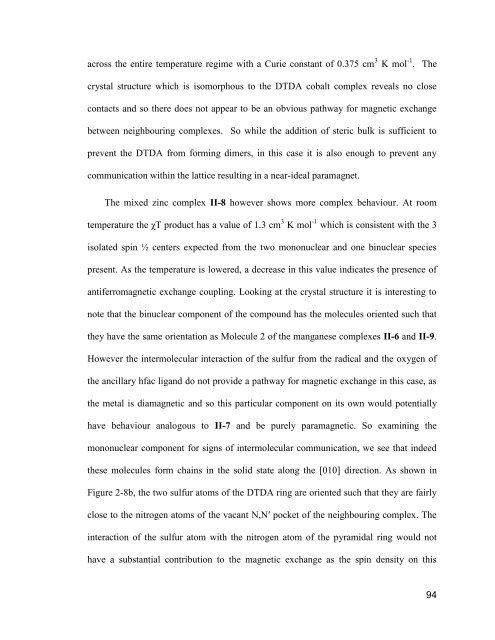1,2,3-Dithiazolyl and 1,2,35-Dithiadiazolyl Radicals as Spin-Bearing ...
1,2,3-Dithiazolyl and 1,2,35-Dithiadiazolyl Radicals as Spin-Bearing ...
1,2,3-Dithiazolyl and 1,2,35-Dithiadiazolyl Radicals as Spin-Bearing ...
Create successful ePaper yourself
Turn your PDF publications into a flip-book with our unique Google optimized e-Paper software.
across the entire temperature regime with a Curie constant of 0.375 cm 3 K mol -1 . The<br />
crystal structure which is isomorphous to the DTDA cobalt complex reveals no close<br />
contacts <strong>and</strong> so there does not appear to be an obvious pathway for magnetic exchange<br />
between neighbouring complexes. So while the addition of steric bulk is sufficient to<br />
prevent the DTDA from forming dimers, in this c<strong>as</strong>e it is also enough to prevent any<br />
communication within the lattice resulting in a near-ideal paramagnet.<br />
The mixed zinc complex II-8 however shows more complex behaviour. At room<br />
temperature the χT product h<strong>as</strong> a value of 1.3 cm 3 K mol -1 which is consistent with the 3<br />
isolated spin ½ centers expected from the two mononuclear <strong>and</strong> one binuclear species<br />
present. As the temperature is lowered, a decre<strong>as</strong>e in this value indicates the presence of<br />
antiferromagnetic exchange coupling. Looking at the crystal structure it is interesting to<br />
note that the binuclear component of the compound h<strong>as</strong> the molecules oriented such that<br />
they have the same orientation <strong>as</strong> Molecule 2 of the manganese complexes II-6 <strong>and</strong> II-9.<br />
However the intermolecular interaction of the sulfur from the radical <strong>and</strong> the oxygen of<br />
the ancillary hfac lig<strong>and</strong> do not provide a pathway for magnetic exchange in this c<strong>as</strong>e, <strong>as</strong><br />
the metal is diamagnetic <strong>and</strong> so this particular component on its own would potentially<br />
have behaviour analogous to II-7 <strong>and</strong> be purely paramagnetic. So examining the<br />
mononuclear component for signs of intermolecular communication, we see that indeed<br />
these molecules form chains in the solid state along the [010] direction. As shown in<br />
Figure 2-8b, the two sulfur atoms of the DTDA ring are oriented such that they are fairly<br />
close to the nitrogen atoms of the vacant N,N′ pocket of the neighbouring complex. The<br />
interaction of the sulfur atom with the nitrogen atom of the pyramidal ring would not<br />
have a substantial contribution to the magnetic exchange <strong>as</strong> the spin density on this<br />
94

















